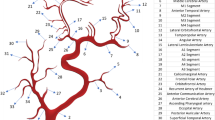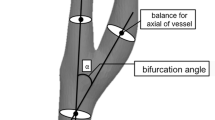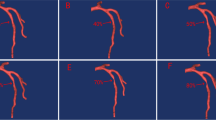Abstract
Computational fluid dynamics (CFD) is an increasingly used method for investigation of hemodynamic parameters and their alterations under pathological conditions, which are important indicators for diagnosis of cardiovascular disease. In hemodynamic simulation models, the employment of appropriate boundary conditions (BCs) determines the computational accuracy of the CFD simulation in comparison with pressure and velocity measurements. In this study, we have first assessed the influence of inlet boundary conditions on hemodynamic CFD simulations. We selected two typical patients suspected of carotid artery disease, with mild stenosis and severe stenosis. Both patients underwent digital subtraction angiography (DSA), magnetic resonance angiography, and the invasive pressure guide wire measured pressure profile. We have performed computational experiments to (1) study the hemodynamic simulation outcomes of distributions of wall shear stress, pressure, pressure gradient and (2) determine the differences in hemodynamic performances caused by inlet BCs derived from DSA and Womersley analytical solution. Our study has found that the difference is related to the severity of the stenosis; the greater the stenosis, the more the difference ensues. Further, in our study, the two typical subjects with invasively measured pressure profile and thirty subjects with ultrasound Doppler velocimeter (UDV) measurement served as the criteria to evaluate the hemodynamic outcomes of wall shear stress, pressure, pressure gradient and velocity due to different outlet BCs based on the Windkessel model, structured-tree model, and fully developed flow model. According to the pressure profiles, the fully developed model appeared to have more fluctuations compared with the other two models. The Windkessel model had more singularities before convergence. The three outlet BCs models also showed good correlation with the UDV measurement, while the Windkessel model appeared to be slightly better (\( R^{2} = 0.942 \)). The structured-tree model was seen to have the best performance in terms of available computational cost and accuracy. The results of our numerical simulation and the good correlation with the computed pressure and velocity with their measurements have highlighted the effectiveness of CFD simulation in patient-specific human carotid artery with suspected stenosis.







Similar content being viewed by others
Abbreviations
- CFD:
-
Computational fluid dynamics
- DSA:
-
Digital subtraction angiography
- MRI:
-
Magnetic resonance imaging
- UDV:
-
Ultrasound Doppler Velocimeter
- MRA:
-
Magnetic resonance angiography
- ST model:
-
Structured-tree model
- CCA:
-
Common carotid artery
- ICA:
-
Internal carotid artery)
- ECA:
-
External carotid artery
- WSS:
-
Wall shear stress
- CTP:
-
Computed tomographic perfusion
References
Albers GW, Caplan LR, Fayad PB, Saver JL, Sherman DG (2002) Transient ischemic attack–proposal for a new definition. New Engl J Med 347:1713
Anayiotos AS, Jones SA, Giddens DP, Glagov S, Zarins CK (1994) Shear Stress at a Compliant Model of the Human Carotid Bifurcation. J Biomech Eng 116:98–106
Bergeron P, Carrier R, Roy D, Blais N, Raymond J (1994) Radiation doses to patients in neurointerventional procedures. AJNR Am J Neuroradiol 15:1809–1812
Blanco PJ, Watanabe SM, Dari EA, Passos MAR, Feijóo RA (2014) Blood flow distribution in an anatomically detailed arterial network model: criteria and algorithms. BIOMECH MODEL MECHAN 13:1303–1330
Chi YW, White CJ, Woods TC, Goldman CK (2007) Ultrasound velocity criteria for carotid in-stent restenosis. Catheter Cardiovasc Interv 69:349–354
Dahl A, Russell D, Nyberg-Hansen R, Rootwelt K, Bakke SJ (1994) Cerebral vasoreactivity in unilateral carotid artery disease. A comparison of blood flow velocity and regional cerebral blood flow measurements. Stroke 25:621
Day TG, Park M, Kinra S (2017) The association between blood pressure and carotid intima-media thickness in children: a systematic review. Cardiol Young 27(7):1295–1305. https://doi.org/10.1017/S1047951117000105
Du T, Hu D, Cai D (2015) Outflow Boundary Conditions for Blood Flow in Arterial Trees. PLoS ONE 10:e128597
Eliasziw M, Kennedy J, Hill MD, Buchan AM, Barnett HJ, North ASCE (2004) Early risk of stroke after a transient ischemic attack in patients with internal carotid artery disease. Can Med Assoc J 170:1105–1109
Figueroa CA, Vignon-Clementel IE, Jansen KE, Hughes TJ, Taylor CA (2006) A coupled momentum method for modeling blood flow in three-dimensional deformable arteries. Comput Method Appl Mech 195:5685–5706
Golfwyn R, Watt T (1967) Arterial pressure pulse contour analysis via a mathematical model for the clinical quantification of human vascular properties. IEEE Trans Biomed Eng 14:11–17
Groen HC, Simons L, van den Bouwhuijsen QJA, Bosboom EMH, Gijsen FJH, van der Giessen AG, van de Vosse FN, Hofman A, van der Steen AFW, Witteman JCM, van der Lugt A, Wentzel JJ (2010a) MRI-based quantification of outflow boundary conditions for computational fluid dynamics of stenosed human carotid arteries. J Biomech 43:2332–2338
Groen HC, van Walsum T, Rozie S, Klein S, van Gaalen K, Gijsen FJH, Wielopolski PA, van Beusekom HMM, de Crom R, Verhagen HJM, van der Steen AFW, van der Lugt A, Wentzel JJ, Niessen WJ (2010b) Three-dimensional registration of histology of human atherosclerotic carotid plaques to in vivo imaging. J Biomech 43:2087–2092
Guan D, Liang F, Gremaud PA (2016) Comparison of the Windkessel model and structured-tree model applied to prescribe outflow boundary conditions for a one-dimensional arterial tree model. J Biomech 49:1583–1592
Guerciotti B, Vergara C, Azzimonti L, Forzenigo L, Buora A, Biondetti P, Domanin M (2016) Computational study of the fluid-dynamics in carotids before and after endarterectomy. J Biomech 49:26–38
Hartree DR, Womersley JR (1937) A method for the numerical or mechanical solution of certain types of partial differential equations. In: Proceedings of the Royal Society of London. Series A, Mathematical and Physical Sciences, pp 353–366
Holdsworth DW, Norley C, Frayne R, Steinman DA, Rutt BK (1999) Characterization of common carotid artery blood-flow waveforms in normal human subjects. Physiol Meas 20:219
Isoda H, Ohkura Y, Kosugi T, Hirano M, Alley MT, Bammer R, Pelc NJ, Namba H, Sakahara H (2010) Comparison of hemodynamics of intracranial aneurysms between MR fluid dynamics using 3D cine phase-contrast MRI and MR-based computational fluid dynamics. Neuroradiology 52:913–920
Karmonik C, Yen C, Grossman RG, Klucznik R, Benndorf G (2009) Intra-aneurysmal flow patterns and wall shear stresses calculated with computational flow dynamics in an anterior communicating artery aneurysm depend on knowledge of patient-specific inflow rates. Acta Neurochir 151:479–485
Kato T, Sone S, Funamoto K, Hayase T, Kadowaki H, Taniguchi N (2016) Effects of inflow velocity profile on two-dimensional hemodynamic analysis by ordinary and ultrasonic-measurement-integrated simulations. Med Biol Eng Comput 54:1331–1339
Ku DN, Giddens DP, Zarins CK, Glagov S (1985a) Pulsatile flow and atherosclerosis in the human carotid bifurcation. Positive correlation between plaque location and low oscillating shear stress. Arteriosclerosis 5:293–302
Ku DN, Giddens DP, Zarins CK, Glagov S (1985b) Pulsatile flow and atherosclerosis in the human carotid bifurcation. Positive correlation between plaque location and low oscillating shear stress. Arterioscler Thromb Vasc Biol 5:293–302
Lal BK, Hobson RW, Goldstein J, Chakhtoura EY, Durán WN (2004) Carotid artery stenting: is there a need to revise ultrasound velocity criteria? J Vasc Surg 39:58–66
Lal BK, Hobson RW, Tofighi B, Kapadia I, Cuadra S, Jamil Z (2008) Duplex ultrasound velocity criteria for the stented carotid artery. J Vasc Surg 47:63–73
Lee C, Uemiya N, Ishihara S, Zhang Y, Qian Y (2013) A comparison of estimation methods for computational fluid dynamics outflow boundary conditions using patient-specific carotid artery. Proc Inst Mech Eng Part H J Eng in Med 227:663–671
Long Q, Xu XY, Ariff B, Thom SA, Hughes AD, Stanton AV (2000) Reconstruction of blood flow patterns in a human carotid bifurcation: a combined CFD and MRI study. J Magn Reson Imaging 11:299–311
Malvè M, Chandra S, García A, Mena A, Martínez MA, Finol EA, Doblaré M (2014) Impedance-based outflow boundary conditions for human carotid haemodynamics. Comput Method Biomech 17:1248–1260
Markl M, Wegent F, Zech T, Bauer S, Strecker C, Schumacher M, Weiller C, Hennig J, Harloff A (2010) In vivo wall shear stress distribution in the carotid artery: effect of bifurcation geometry, internal carotid artery stenosis, and recanalization therapy. Circ Cardiovasc Imaging 3:647–655
Marshall I, Zhao S, Papathanasopoulou P, Hoskins P, Xu XY (2004) MRI and CFD studies of pulsatile flow in healthy and stenosed carotid bifurcation models. J Biomech 37:679–687
Maurits NM, Loots GE, Veldman AEP (2007) The influence of vessel wall elasticity and peripheral resistance on the carotid artery flow wave form: A CFD model compared to in vivo ultrasound measurements. J Biomech 40:427–436
Meinders JM, Hoeks AP (2004) Simultaneous assessment of diameter and pressure waveforms in the carotid artery. Ultrasound Med Biol 30:147–154
Milner JS, Moore JA, Rutt BK, Steinman DA (1998) Hemodynamics of human carotid artery bifurcations: computational studies with models reconstructed from magnetic resonance imaging of normal subjects. J Vasc Surg 28:143–156
Oikawa M, Ota H, Takaya N, Miller Z, Hatsukami TS, Yuan C (2009) Carotid magnetic resonance imaging. Circ J 73:1765–1773
Olufsen MS (1999) Structured tree outflow condition for blood flow in larger systemic arteries. Am J Physiol Heart Circ Physiol 276:H257–H268
Olufsen MS, Peskin CS, Kim WY, Pedersen EM, Nadim A, Larsen J (2000) Numerical simulation and experimental validation of blood flow in arteries with structured-tree outflow conditions. Ann Biomed Eng 28:1281–1299
Papathanasopoulou P, Zhao S, Köhler U, Robertson MB, Long Q, Hoskins P, Yun Xu X, Marshall I (2003) MRI measurement of time-resolved wall shear stress vectors in a carotid bifurcation model, and comparison with CFD predictions. J Magn Reson Imaging 17:153–162
Pereira VM, Brina O, Marcos Gonzales A, Narata AP, Bijlenga P, Schaller K, Lovblad KO, Ouared R (2013) Evaluation of the influence of inlet boundary conditions on computational fluid dynamics for intracranial aneurysms: a virtual experiment. J Biomech 46:1531–1539
Perktold K, Resch M, Florian H (1991) Pulsatile non-Newtonian flow characteristics in a three-dimensional human carotid bifurcation model. J Biomech Eng 113:464–475
Pijls NH, De Bruyne B, Peels K, Van Der Voort PH, Bonnier HJ, Bartunek JKJ, Koolen JJ (1996) Measurement of fractional flow reserve to assess the functional severity of coronary-artery stenoses. The New England journal of medicine 334:1703–1708
Piskin S, Celebi MS (2013) Analysis of the effects of different pulsatile inlet profiles on the hemodynamical properties of blood flow in patient specific carotid artery with stenosis. Comput Biol Med 43:717–728
Pollanen MS (1992) Dimensional optimization at different levels of the arterial hierarchy. J Theor Biol 159:267–270
Roubin GS, New G, Iyer SS, Vitek JJ, Al-Mubarak N, Liu MW, Yadav J, Gomez C, Kuntz RE (2001) Immediate and late clinical outcomes of carotid artery stenting in patients with symptomatic and asymptomatic carotid artery stenosis. Circulation 103:532–537
Saba PS, Roman MJ, Pini R, Spitzer M, Ganau A, Devereux RB (1993) Relation of arterial pressure waveform to left ventricular and carotid anatomy in normotensive subjects. J Am Coll Cardiol 22:1873–1880
Schrauwen JTC, Coenen A, Kurata A, Wentzel JJ, van der Steen AFW, Nieman K, Gijsen FJH (2016) Functional and anatomical measures for outflow boundary conditions in atherosclerotic coronary bifurcations. J Biomech 49:2127–2134
Sherman TF (1981) On connecting large vessels to small. The meaning of Murray9 s law. J Gen Physiol 78:431–453
Sherwin JAKP (2008) Lumped parameter outflow models for 1-D blood flowsimulations: effect on pulse waves and parameter estimation. Commun Comput Phys 4(2):317–336
Sousa LC, Castro CF, António CC, Chaves R (2012) Blood flow simulation and vascular reconstruction. J Biomech 45:2549–2555
Spencer MP, Thomas GI, Moehring MA (1992) Relation between middle cerebral artery blood flow velocity and stump pressure during carotid endarterectomy. Stroke 23:1439
Steinman DA (2002) Image-based computational fluid dynamics modeling in realistic arterial geometries. Ann Biomed Eng 30:483–497
Steinman DA, Poepping TL, Tambasco M, Rankin RN, Holdsworth DW (2000) Flow patterns at the stenosed carotid bifurcation: effect of concentric versus eccentric stenosis. Ann Biomed Eng 28:415–423
Sweet WH, Bennett HS (1948) Changes in internal carotid pressure during carotid and jugular occlusion and their clinical significance. J Neurosurg 5:178–195
Sweet WH, Sarnoff SJ, Bakay L (1950) A clinical method for recording internal carotid pressure; significance of changes during carotid occlusion. Surg Gynecol Obstet 90:327
Tedla YG, Gepner AD, Vaidya D, Colangelo L, Stein JH, Liu K, Greenland P (2017) Association between long-term blood pressure control and ten-year progression in carotid arterial stiffness among hypertensive individuals: the multiethnic study of atherosclerosis. J Hypertens 35:862–869
Thomas JB, Milner JS, Rutt BK, Steinman DA (2003) Reproducibility of image-based computational fluid dynamics models of the human carotid bifurcation. Ann Biomed Eng 31:132–141
Tu S, Barbato E, Koszegi Z, Yang J, Sun Z, Holm NR, Tar B, Li Y, Rusinaru D, Wijns W, Reiber JH (2014) Fractional flow reserve calculation from 3-dimensional quantitative coronary angiography and TIMI frame count: a fast computer model to quantify the functional significance of moderately obstructed coronary arteries. JACC Cardiovasc Interv 7:768–777
Urquiza SA, Blanco PJ, Vénere MJ, Feijóo RA (2006) Multidimensional modelling for the carotid artery blood flow. Comput Method Appl Mech 195:4002–4017
Vignon-Clementel IE, Alberto Figueroa C, Jansen KE, Taylor CA (2006) Outflow boundary conditions for three-dimensional finite element modeling of blood flow and pressure in arteries. Comput Method Appl Mech 195:3776–3796
Waddell TK, Dart AM, Medley TL, Cameron JD, Kingwell BA (2001) Carotid pressure is a better predictor of coronary artery disease severity than brachial pressure. Hypertension 38:927–931
Willemet M, Lacroix V, Marchandise E (2011) Inlet boundary conditions for blood flow simulations in truncated arterial networks. J Biomech 44:897–903
Younis HF, Kaazempur-Mofrad MR, Chung C, Chan RC, Kamm RD (2003) Computational analysis of the effects of exercise on hemodynamics in the carotid bifurcation. Ann Biomed Eng 31:995–1006
Younis HF, Kaazempur-Mofrad MR, Chan RC, Isasi AG, Hinton DP, Chau AH, Kim LA, Kamm RD (2004) Hemodynamics and wall mechanics in human carotid bifurcation and its consequences for atherogenesis: investigation of inter-individual variation. Biomech Model Mech 3:17–32
Zarins CK, Giddens DP, Bharadvaj BK, Sottiurai VS, Mabon RF, Glagov S (1983) Carotid bifurcation atherosclerosis. Quantitative correlation of plaque localization with flow velocity profiles and wall shear stress. Circ Res 53:502–514
Zhao SZ, Papathanasopoulou P, Long Q, Marshall I, Xu XY (2003) Comparative study of magnetic resonance imaging and image-based computational fluid dynamics for quantification of pulsatile flow in a carotid bifurcation phantom. Ann Biomed Eng 31:962–971
Acknowledgements
This work was supported in part, by National Key Research and Development Program of China (2016YFC1301700),Science technology and innovation committee of Shenzhen for research projects (Grant JCYJ20151030151431727, JCYJ20170413114916687, SGLH20161212104605195, and JCYJ20170307165309009), the Guangzhou Science and Technology Planning Project (No. 201704020079), the South Wisdom Valley Innovation Team Plan (2015CXTD05), the National High Technology Research and Development Program (863 Program) SS2015AA020109, and the National Natural science Foundational of China (Grant 61771464).
Author information
Authors and Affiliations
Corresponding author
Ethics declarations
Conflict of interest
All authors disclose any financial and personal relationships with other people or organizations that could have inappropriately influenced the work.
Rights and permissions
About this article
Cite this article
Xu, P., Liu, X., Zhang, H. et al. Assessment of boundary conditions for CFD simulation in human carotid artery. Biomech Model Mechanobiol 17, 1581–1597 (2018). https://doi.org/10.1007/s10237-018-1045-4
Received:
Accepted:
Published:
Issue Date:
DOI: https://doi.org/10.1007/s10237-018-1045-4




